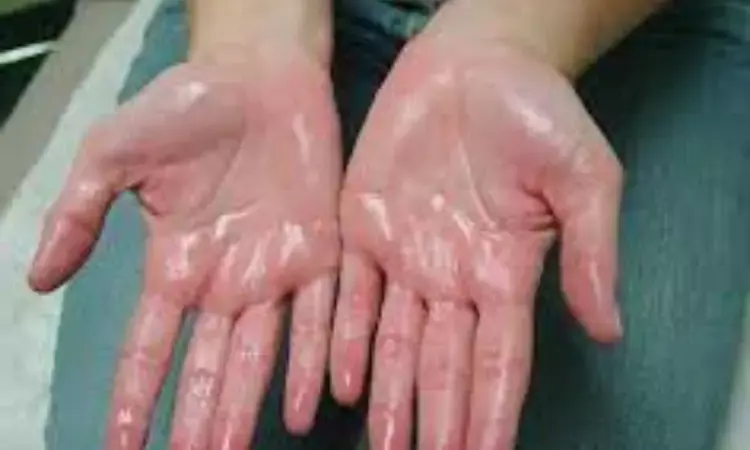- Home
- Medical news & Guidelines
- Anesthesiology
- Cardiology and CTVS
- Critical Care
- Dentistry
- Dermatology
- Diabetes and Endocrinology
- ENT
- Gastroenterology
- Medicine
- Nephrology
- Neurology
- Obstretics-Gynaecology
- Oncology
- Ophthalmology
- Orthopaedics
- Pediatrics-Neonatology
- Psychiatry
- Pulmonology
- Radiology
- Surgery
- Urology
- Laboratory Medicine
- Diet
- Nursing
- Paramedical
- Physiotherapy
- Health news
- Fact Check
- Bone Health Fact Check
- Brain Health Fact Check
- Cancer Related Fact Check
- Child Care Fact Check
- Dental and oral health fact check
- Diabetes and metabolic health fact check
- Diet and Nutrition Fact Check
- Eye and ENT Care Fact Check
- Fitness fact check
- Gut health fact check
- Heart health fact check
- Kidney health fact check
- Medical education fact check
- Men's health fact check
- Respiratory fact check
- Skin and hair care fact check
- Vaccine and Immunization fact check
- Women's health fact check
- AYUSH
- State News
- Andaman and Nicobar Islands
- Andhra Pradesh
- Arunachal Pradesh
- Assam
- Bihar
- Chandigarh
- Chattisgarh
- Dadra and Nagar Haveli
- Daman and Diu
- Delhi
- Goa
- Gujarat
- Haryana
- Himachal Pradesh
- Jammu & Kashmir
- Jharkhand
- Karnataka
- Kerala
- Ladakh
- Lakshadweep
- Madhya Pradesh
- Maharashtra
- Manipur
- Meghalaya
- Mizoram
- Nagaland
- Odisha
- Puducherry
- Punjab
- Rajasthan
- Sikkim
- Tamil Nadu
- Telangana
- Tripura
- Uttar Pradesh
- Uttrakhand
- West Bengal
- Medical Education
- Industry
Novel lotion formulation effective for reducing palmar sweat volume in primary palmar hyperhidrosis

Japan: A randomized controlled study of 284 patients found the use of 20% oxybutynin hydrochloride lotion (20% OL) superior to placebo in reducing palmar sweat volume among patients with primary palmar hyperhidrosis (PPHH). The study was featured in the Journal of the American Academy of Dermatology on March 27, 2023
Most application site adverse events were moderate, and only 3.5% of the patients in the treatment group experienced mild thrust as an adverse event. No adverse events resulted in treatment discontinuation.
Primary or essential hyperhidrosis is a disorder characterized by chronic, excessive sweating during rest unrelated to the body's need for heat loss. It can impact one or more body areas in the head, feet, armpits, hands and the inguinal region. According to the literature, the primary hyperhidrosis prevalence ranges from 1% to 3%. The nomenclature of primary hyperhidrosis is related to the anatomical locations: palmar region (palmar hyperhidrosis), face and scalp (craniofacial hyperhidrosis), plantar regions (plantar hyperhidrosis), inguinal region (inguinal hyperhidrosis), and armpits (axillary hyperhidrosis).
About 3% of the population is affected by palmar hyperhidrosis, which significantly impacts the quality of life. It evolves from a localized hyperactivity of the sympathetic autonomic system and can be triggered by stressful events.
Considering that no previous controlled studies have been explicitly designed or adequately powered to show topical oxybutynin's efficacy for palmar hyperhidrosis by using quantitative measures, Tomoko Fujimoto and a research team from Japan aimed to investigate the effectiveness of 20% oxybutynin hydrochloride lotion (20% OL) in decreasing palmar sweat volume in primary palmar hyperhidrosis patients.
The researchers conducted a randomized controlled trial comprising Japanese patients aged 12 years and older with primary palmar hyperhidrosis. One hundred forty-four patients received 20% OL, and 140 received a placebo on both palms once daily for four weeks. Ventilated capsule method was used to measure palmar sweat volume. The response was defined as a reduction of sweat volume of at least 50% from baseline (primary outcome).
The authors reported the following findings:
· At week 4, the responder rate for sweat volume was significantly higher in the 20% OL arm than in the placebo arm (52.8% vs 24.3%, respectively; treatment difference, 28.5%).
· No serious adverse events (AEs) occurred, and no AEs led to treatment discontinuation.
"A novel topical 20% oxybutynin hydrochloride lotion formulation demonstrated efficacy in reducing palmar sweat volume versus placebo and had a favourable side-effect profile," the researchers conclude.
Reference:
Fujimoto T, Terahara T, Okawa K, Inakura H, Hirayama Y, Yokozeki H. A novel lotion formulation of 20% oxybutynin hydrochloride for the treatment of primary palmar hyperhidrosis: A randomized, placebo-controlled, double-blind, phase III study in Japan. J Am Acad Dermatol. 2023 Mar 27:S0190-9622(23)00511-X. doi: 10.1016/j.jaad.2023.03.025. Epub ahead of print. PMID: 36990320.
Dr Kamal Kant Kohli-MBBS, DTCD- a chest specialist with more than 30 years of practice and a flair for writing clinical articles, Dr Kamal Kant Kohli joined Medical Dialogues as a Chief Editor of Medical News. Besides writing articles, as an editor, he proofreads and verifies all the medical content published on Medical Dialogues including those coming from journals, studies,medical conferences,guidelines etc. Email: drkohli@medicaldialogues.in. Contact no. 011-43720751


